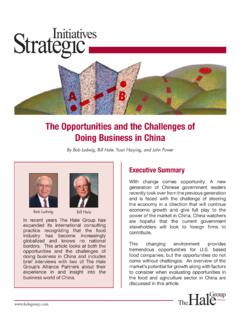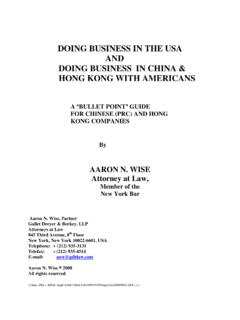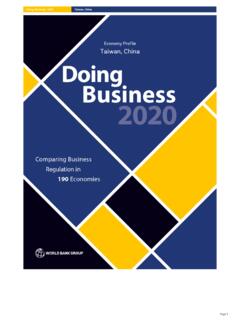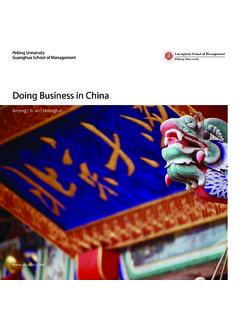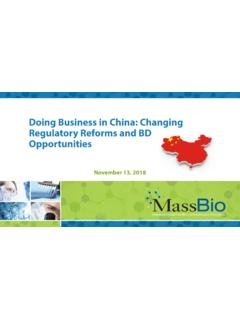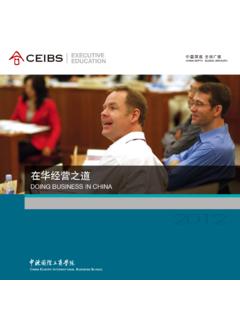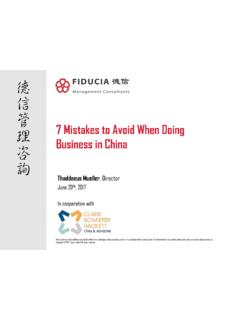Transcription of UHY Doing Business Guide
1 Doing Business IN CHINA CONTENTS 1 Introduction 3 2 Business environment 4 3 Foreign Investment and Incentives 10 4 Setting up a Business 12 5 Labour 19 6 Taxation 20 7 Accounting & reporting 27 8 UHY Representation in China 31 3 Doing Business IN CHINA 1 INTRODUCTION UHY is an international organisation providing audit, accountancy, Business management and consultancy services through financial Business centres in around 90 countries worldwide. Business partners work together throughout the network to conduct transnational operations for clients as well as offering specialist knowledge and experience within their own national borders. Global specialists in various industry and market sectors are also available for consultation. This detailed report providing key issues and information for investors considering Business operation in China has been provided by the office of UHY representative there: ZHONGHUA CPAS LLP 6F, 100 Bund Square 100 Zhongshan South Road Shanghai 200010 The People s Republic of China Phone +86 (21) 6352 5500 Website Email You are invited to contact Mr Sun Yong with any further inquiries you may have.
2 A detailed firm profile for UHY s representation in China can be found in section 8. Information in the following pages has been updated so that it is effective at the date shown, but inevitably it is both general and subject to change and should be used for guidance only. For specific matters, investors are strongly advised to obtain further information and take professional advice before making any decisions. This publication is current at November 2017. We look forward to helping you do Business in China. 4 Doing Business IN CHINA 2 Business ENVIRONMENT The People's Republic of China (PRC) is situated in eastern Asia and is bounded by the Pacific to the east. It is the third largest country in the world and has a population of billion, which means one out of every five individuals in the world is Chinese. BACKGROUND FACTS (2016) Population billion Currency RMB / CNY Main Language Mandarin Chinese Exchange Rate CNY / 1 USD (2016/12/31) Attracting foreign investment is one of China s fundamental policies.
3 China is the largest foreign investment recipient country in the world. With one of the four oldest civilisations in the world, China has a written history dating back 4,000 years and boasts rich cultural relics and historical sites. Chinese inventions include the compass, paper-making, gunpowder and printing. Over the past centuries, China stood as a leading civilisation, outpacing the rest of the world in the arts and sciences. But in the 19th and early 20th centuries, China was beset by civil unrest, major famines, military defeats and foreign occupation. In 1949, the Communists under Mao Zedong established the new People s Republic of China. After 1978, his successor Deng Xiaoping gradually introduced market-oriented reforms and decentralised economic decision-making. GOVERNMENT The Chinese Communist party controls the government. ADMINISTRATIVE DIVISIONS There are 23 provinces, five autonomous regions, four municipalities and two Special Administrative Regions of Hong Kong and Macau.
4 China considers Taiwan its 23rd province. LEGAL SYSTEM The legal system is a complex amalgam of custom and statute, with a largely criminal law. A rudimentary civil code has been in effect since 1 January 1987 and new legal codes in effect since 1 January 1980. Continuing efforts are being made to improve civil, administrative, criminal and commercial law. There are three branches of government: Executive branch The chief of state is President Xi Jinping (since March 2013) The head of government is Premier Li Keqiang (since March 2013) Legislative branch the National People's Congress with 2,987 seats; members are elected by municipal, regional and provincial people's congresses to serve five-year terms 5 Doing Business IN CHINA Judicial branch the Supreme People's Court (judges appointed by the National People's Congress), local people s courts (comprised of higher, intermediate and local courts) and special people s courts (primarily military, maritime and railway transport courts).
5 The 19th National Congress of the Communist Party of China (CPC) which just concluded in Beijing is a landmark event. It represents that the Party has fortified itself with a new theory - the Xi Jinping Thought on Socialism with Chinese Characteristics for a New Era" and will embark on a journey towards building China into a great modern socialist country by 2049. It also marks that the world s second largest economy stands ready to play a bigger role in shaping the world s future agenda and to share the China Solution with other countries. These developments will not only bring profound impacts on China s economic and social development in the next 30 years, but also generate significant repercussions at a global scale, given the size of the Chinese economy and its rising influence in the ECONOMY The Chinese economy has sustained high-speed growth since its opening-up and reform, and China has become the third largest trading nation and the fourth largest economic entity in the world.
6 The national economy kept stable and comparatively fast growth in 2016. The gross domestic product (GDP) of the year was 10, billion USD, up by percent over the previous year (according to statistics released by China s National Bureau of Statistics in February 2017) the lowest rate since 1999. China has pledged to transform its economic growth model to be less driven by exports and investment and more by domestic consumption and moving up the supply chain . A slowdown is to be expected during the process. The slower economic growth is generally welcomed as it will ensure steadier growth of the Chinese economy in the future. Government stimulus measures introduced since early 2012 have helped reverse the slowdown and stabilise growth. In May 2012, the government shifted its top priority from taming inflation to stabilising growth. It has moderately eased its grip over lending, approved massive construction projects and stepped up tax reductions to buoy the economy.
7 As a result, Chinese gross domestic product (GDP) reached CNY 74, billion in 2016, compared to in 2015), ensuring China remained one of the major countries contributing to world economy growth. In 2016, the world financial crisis entered its ninth year. The basis of the world economic recovery is still fragile with persistent downward pressure on domestic economies. In such a complex international environment, China adheres to scientific development and accelerating the transformation of economic development, while maintaining stability and the strengthening and improving of macro-control to ensure firm growth and to stabilise the operation of the national economy. 6 Doing Business IN CHINA KEY FACTS The employment continued to grow. At the end of 2016, the number of employed people in China was million, and that in urban areas was million. The newly increased employed people in urban areas numbered million. The urban unemployment rate registered was percent at the year end, slightly lower than last year s percent.
8 The total number of migrant workers in 2015 was million, up by percent over that of 2015. The number of migrant workers who left hometowns and worked in other places was million, increased by percent, and those who worked in their own localities reached million, up by percent. The labour productivity increased steadily. The ratio between GDP and the total employment was 13,669 USD per person, an increase of percent. The consumer prices were basically stable. The consumer prices in 2016 went up by 2 percent over the previous year. Of this total, the prices for food went up by percent. The prices for investment in fixed assets down by percent. The producer prices and the purchasing prices for manufactured goods were down by percent and percent respectively. The producer prices for farm products were up by percent. A number of 46 out of 70 large and medium-sized cities experienced rises of monthly sales prices (month-on-month) for new commercial residential buildings at the end of the 2016.
9 The fiscal revenue grew steadily in 2016. The total public revenue reached 2, billion USD, up by percent or an increase of billion USD over that in the previous year. Of this total, the taxes collected in the whole year reached 1, billion USD, up by percent or an increase of billion USD over 2015. The foreign exchange reserve decreased. At the end of 2016, China s foreign exchange reserves reached 3, billion US dollars, a decrease by billion US dollars as compared with that at the end of the previous year. At the end of the year, the average exchange rate was RMB to 1 USD. Depreciation by percent over previous year. The industrial production grew steadily. In 2016, the total value added of the industrial sector was 3, billion USD, up by 6 percent over the previous year. The value added of industrial enterprises above the designated size increased by 6 percent. The industrial enterprises above the designated size, in terms of ownership, by foreign investors and investors from Hong Kong, Macao and Taiwan grew by percent and that of private enterprises grew by percent.
10 Profits made in 2016 were billion USD, a increase by percent over the previous year. 7 Doing Business IN CHINA By the end of 2016, the installed power generation capacity was 1, million kilowatts, up by percent over that of the previous year. In 2016, the value added of construction enterprises in China was billion USD, up by percent over the previous year. The profits made by construction enterprises qualified for general contracts and specialized contracts reached billion USD, up by percent, The investment in fixed assets grew fast. The completed investment in fixed assets of the country in 2016 was 8, billion USD, up by percent over the previous year, or a real growth of percent after deducting price factors. To which the investment in the primary industry was billion USD, up by percent; that in the secondary industry was 3, billion USD, up by percent; and that in the tertiary industry was 4, billion USD, up by percent. In 2016, the investment in real estate development was 1, billion USD, up by percent.











